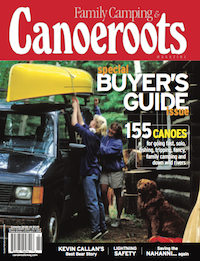I used to scout rapids with one goal in mind: finding the safest way down. My game plans were limited to three options—Plan A: Shoot for the V; Plan B: When in doubt, straighten ‘er out and paddle like hell; and Plan C: Walk it.
I applied this three-pronged approach through my first 15 years of tripping, years when the sight of a smooth horizon line on the river would fill me with excitement, but also a sense of dread. Visions of wrapped canoes and loose gear bobbing in downstream eddies drove me to the shore to pick out the least consequential route through what- ever mess of waves and rocks I came to. I could pick out the safest line of a rapid from 10 metres deep in the forest under a crescent moon with one eye closed.
I paddled rapids because they were just part of canoeing rivers. I was a traveller, not a tourist, and I was not on the river to play. I was happy; my bow paddlers were happy—mostly because they stayed dry. Only once in a while did I get the feeling I was missing something. I stumbled upon that some- thing one day in the middle of a technical class III.
The rapid bent to the right, with a welcoming eddy on the inside and a choppy wave train down the middle leading to a pourover I didn’t want any part of. On the outside of the bend were several large rocks with big pillows of water pushing against them leaving swirling little eddies behind, but I didn’t pay much attention to them.
Our plan A involved skirting the waves and eddying in along the right bank, as soon as we could. In order to keep to the right of the waves before turn- ing and digging hard for the eddy, we initiated our tried-and-true back ferry and I pointed the canoe, and my trusting girlfriend Tanis in the bow, toward the middle of the river. But we had to drift further downstream than I wanted to avoid a pillow. By the time we started pushing, our flexing paddles couldn’t buy us the purchase we needed to stay on the inside of the bend. We were now in the thick of things and heading for someplace thicker.
In a perfect moment of clarity that you’d need to spend 10 years in a Buddhist monastery to manufacture, I realized it was time to add to our bag of tricks. Plans A, B and C were lost to us now. We were left with plan D which meant placing significant confidence in the abilities I hoped we had acquired during years of taking the easiest way down. We would need to will our canoe over to one of the outside eddies.
Tanis was not in touch with this plan D. In fact, she was still back paddling in a touching display of confidence in our back ferrying abilities. But this was no time for sentimentality. I had caught a glimpse of whitewater enlightenment and it was illuminating a new path across the river.
I managed to convey that we needed to take control of the situation and our paddles started swinging. We crossed the current just high enough to drop through a slot between two rocks. After punching the hole and taking advantage of the slower water behind it we angled hard left and powered across some crashing standing waves and into one of the miniature eddies that once seemed so distant.
When we screeched into the eddy behind a barely visible rock my head was half full of relief, my heart half full of panic, and the canoe half full of water. We wobbled our gunwales into the river on both sides and Tanis spun and glared at me. I could tell, even through the tears welling in her eyes, that she was mad. Time stood still. Her hair looked extra messy. Maybe I should get her a helmet, I thought.
Fortunately, this moment we were about to share was interrupted by hoots and hollers from across the river. Our friends didn’t realize we had flubbed our back ferry. They thought we meant to pick our way across the river.
I put my head down and bailed while I thought of a way to convince our friends that this had been our plan all along and convince Tanis that I was as surprised as she was.
Now any scouting we do begins with a search for creative lines. We look for little currents and waves that might give us some advantage over the river or an opportunity to try something new. Sometimes we find a feature in the middle of a rapid that we would have straight-lined a few years ago and we eddy out and play in it just to enjoy the rapid and the feel the river. Other times, hit- ting mid-stream micro-eddies and doing jet ferries across the river on a wave are useful manoeuvres for getting down complicated rapids we would have portaged years ago.
It doesn’t matter how it happened, going for the other side of the river that day was a revelation.
Patrick Yarnell and Tanis are still paddling together, and he did end up buying her a helmet.




